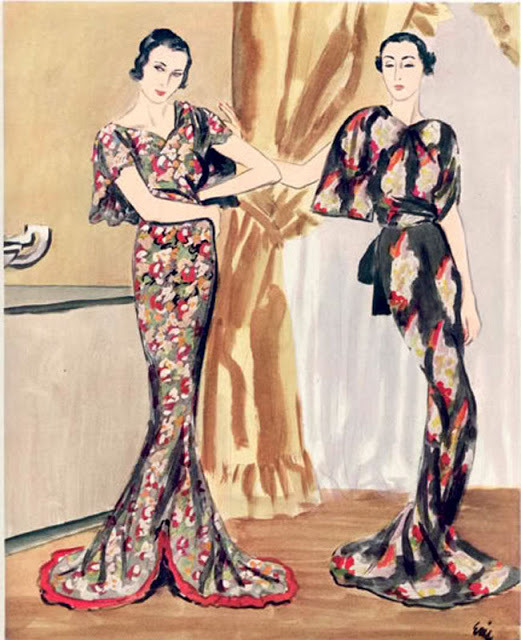Photo

Fun facts about the panier:
1. Women often had to walk sideways through doors to fit through.
2. Railings were added to furniture. This was mostly done in order to prevent dresses from knocking things off tables.
3. Typically made from wood or whalebones.
4. Some paniers had pocket hoops. These were lighter paniers that had added space within (by adding cloth to a waist band) to store small items.
One man said that the hoop was made “to keep us (men) at a distance.” I like that notion.
321 notes
·
View notes
Photo


Paniers are the skirt supports of the 1700′s. While paniers were worn as early as 1720, they were most common from during the 1770′s and 1780′s. Paniers is the french word for basket, which makes sense since the style literally makes a woman look like she has a basket balancing on both hips.
185 notes
·
View notes
Photo

This lovely picture is from a manuscript from the middle ages. As you can see, this man on stilts is wearing a long liripipe hood and likely enjoying his day.
#medieval#fashion history#stilts#liripipe#hood#middle ages#this is why i like fashion history#this picture right here#just hanging around on his stilts
379 notes
·
View notes
Photo


Medieval (300-1300)
A liripipe hood (also known as a cornette) is a fitted hood that has a long tube of fabric hanging down from the crown of the hood. Most liripipes include a short shoulder cape.
Images above are from Woven into the Earth by Else Ostergard. The first hood (restored) was originally white. The second hood had a grey warp/white weft and is one of the better preserved hoods from the time.
2K notes
·
View notes
Text
Medieval
I got the book Woven into the Earth by Else Ostergard and now I’m reminded about how much I love Medieval clothing, especially the liripipe… Look forward to some medieval posts.
12 notes
·
View notes
Photo









Eric (1891-1958)
Carl Erickson, also known as Eric, was a fashion illustrator for Vogue and other fashion advertisements from 1916 into the 1950′s.
Please take some time to admire Carl Erickson’s fashion illustrations.
52 notes
·
View notes
Photo


“When a woman smiles, then her dress should smile too.”
-Madeleine Vionnet
24 notes
·
View notes
Photo





Madeleine Vionnet (1876-1975)
Madeleine Vionnet did not like to be called a fashion designer. And yet she is (in my opinion) one of the most influential dress makers in history. While her dresses may look minimal, her designs are all calculated perfectly, and made with superb workmanship. Vionnet was known for using the bias to create body conscience dresses that draped perfectly.
This blurb from “The Fashion Book” (Phaidon) sums her look up perfectly: “Madeleine Vionnet’s materials does not hang on the models but accompanies them,following their natural line, achieving a modern Grecian silhouette.”
Vionnet’s dresses were the height of fashion in the 1920′s and 1930′s.
#madeleine vionnet#fashion#bias#fashion history#1930's#1920's#fashion designer#i love madeleine vionnet too much
36 notes
·
View notes
Photo



One of the things I love most about crinoline culture is the way that the style was teased by cartoonists of the time. Crinolines created a lot of issues for women, yet one was not considered decently dressed without wearing one.
In the first picture we see the use of long handled trays in order to hand a woman her drink over her crinoline.
The second picture pokes fun at a woman asking her husband to pack her crinoline in his suitcase.
The third shows how a woman would have to hang her crinoline out in order to fit onto public transportation.
On a more serious note, crinolines were extremely flammable. Many women were burnt to death by crinoline catching fire.
167 notes
·
View notes
Photo



The cage crinoline of the 1860′s- The crinoline (crin- horsehair, lin-linen) was used to add volume and shape to skirts in the Victorian era. In the 1850′s steel hoop crinolines were invented. The1860′s styles featured a full backs, flat front shape.
(Images- The Kyoto Costume Institute/ Costume James Laver)
#victorian#fashion history#crinoline#steel#cage crinoline#day dress#evening gown#dress#fashion#1860s#horsehair#hoop
74 notes
·
View notes
Photo

Walking costume, 1906. Jacket, skirt, blouse, cummerbund. Wool and cotton. Photos: Mats Landin. Nordic Museum, Sweden
Source
559 notes
·
View notes
Photo

Robes a la Francaise
1770-1774
“The vogue of the stripe spread through all the social classes starting in the 1700′s” (The Kyoto Fashion Institute).
46 notes
·
View notes
Photo




Gilbert Adrian (1903-1959)
Adrian is one of my favorite American designers. As a costume designer, he was able to dress movie stars like Joan Crawford and Marlene Dietrich. Through film Adrain was able to influence women of fashion. What made Adrain great was his use of luxurious fabrics in simple, yet bold designs.
Adrian created the “Coat Hanger Look”(think inverted triangle, shoulder pads and slim waist and skirt). He is probably most noted for designing the costumes of “The Wizard of Oz”. When I think of Adrian, I think of Joan Crawford. She looked stunning in his structured suits and draped gowns.
In 1942 Adrian was able to retire costume work and opened a fashion house, featuring his trademark suits and beautiful gowns.
#Adrian#gilbert adrian#Adrian Adolph Greenberg#1930's#1940's#joan crawford#american designer#costume design#wizard of oz#coathanger look#fashion#fashion history#designer#couture
100 notes
·
View notes
Photo



In the early 1700′s the loose fitted, Sacque gown (aka robe volante or robe battante) gained popularity. These gowns draped from the shoulder to floor, typically with double folded pleats known as “Watteau Pleats”.
Some people believe that this style gown is evidence of a lack of etiquette within french court while waiting for Louis XV to grow up after his fathers death. I can see the appeal in wearing robe volante to court. It’s basically wearing a giant tent. It appeared to be a relaxed look, but women still wore stays under it.
Later, Sacque evolved to the robe a la Francaise- a fitted bodice front with the Watteau back.
43 notes
·
View notes